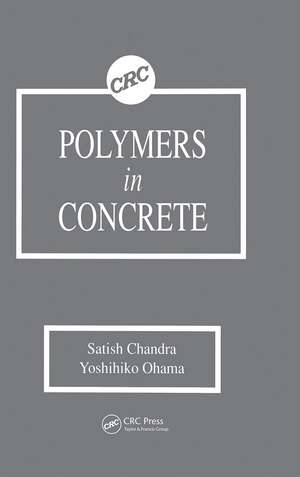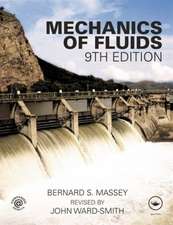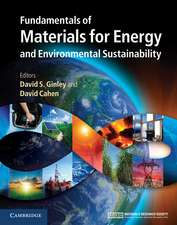Polymers in Concrete
Autor Satish Chandra, Yoshihiko Ohamaen Limba Engleză Hardback – 5 mai 1994
Preț: 2744.12 lei
Preț vechi: 3346.50 lei
-18% Nou
Puncte Express: 4116
Preț estimativ în valută:
525.07€ • 548.23$ • 434.58£
525.07€ • 548.23$ • 434.58£
Carte tipărită la comandă
Livrare economică 04-18 aprilie
Preluare comenzi: 021 569.72.76
Specificații
ISBN-13: 9780849348150
ISBN-10: 0849348153
Pagini: 224
Ilustrații: 24 black & white tables, 28 black & white halftones
Dimensiuni: 156 x 234 mm
Greutate: 0.49 kg
Ediția:1
Editura: CRC Press
Colecția CRC Press
Locul publicării:Boca Raton, United States
ISBN-10: 0849348153
Pagini: 224
Ilustrații: 24 black & white tables, 28 black & white halftones
Dimensiuni: 156 x 234 mm
Greutate: 0.49 kg
Ediția:1
Editura: CRC Press
Colecția CRC Press
Locul publicării:Boca Raton, United States
Public țintă
ProfessionalCuprins
L INTRODUCTION -- 2. NATURAL AND SYNTHETIC POLYMERS -- 2.1 Natural Polymers -- 2.1.1 The Oldest Natural Polymer, Bitumen -- 2.1.2 Use of Asphalt as an Impregnation Material -- 2.1.3 Materials Used in the Great Wall of China -- 2.1.4 Materials Used in India -- 2.1.5 Materials Used in Other Places -- 2.2 Synthetic Polymers -- 2.2.1 Soil Stabilization with Synthetic Polymers -- 2.2.2 Early Use of Synthetic Polymers in Concrete -- 2.2.3 Thermoplastics, Thermosets, and Elastomers -- 2.2.4 Water-Soluble Polymers -- 2.3 Concluding Remarks -- 3. DURABILITY PROBLEMS IN CONCRETE -- 3.1 Chemical Additives -- 3.2 Carbonation -- 3.3 Industrial Gases -- 3.4 Alkali-Aggregate Reaction -- 3.5 Water as an Agent of Deterioration -- 3.6 Need for Long-Term Research -- 3.7 Choice of Building Site -- 3.8 Errors in Design and Poor Workmanship -- 3.9 Some Cases -- 3.9.1 Bridges -- 3.9.2 Concrete Balconies -- 3.10 Reinforced Concrete Chimneys -- 3.11 Poor-Quality Aggregates -- 3.12 Corrosion of Steel Reinforcement -- 3.13 Freeze-Thaw Resistance -- 3.14 Concluding Remarks -- 4. MECHANISMS OF CONCRETE DETERIORATION -- 4.1 Carbonation of Concrete -- 4.1.1 Chemical Reaction -- 4.1.2 pH Profile -- 4.1.3 Shrinkage-Humidity Relationship -- 4.1.4 Effects of Cracks -- 4.2 Chloride-Induced Corrosion -- 4.3 Alkali-Aggregate Reaction -- 4.3.1 Alkali-Silica Reaction -- 4.3.2 Alkali-Carbonate Reaction -- 4.3.3 Alkali-Silicate Reaction -- 4.4 Freeze-Thaw Attack -- 4.4.1 Hydraulic Pressure -- 4.4.2 Osmotic Pressure -- 4.4.3 Chemical Interactions -- 4.5 Erosion and Cavitation -- 4.6 Chemical Attacks -- 4.6.1 Pollution and Acid Attack -- 4.6.2 Sulfate Attack -- 4.6.3 Ammonium Salts Attack -- 4.6.3.1 Ammonium Sulfate Action -- 4.6.3.2 Ammonium Chloride Action -- 4.6.3.3 Ammonium Nitrate Action -- 4.7 Efflorescence -- 4.8 Concluding Remarks -- 5. CLASSIFICATION OF CONCRETE-POLYMER COMPOSITES -- 5.1 Polymer-Modified (or Cement) Mortar and Concrete -- 5.1.1 Definition -- 5.1.2 Principles of Polymer Modification -- 5.1.2.1 Latex Modification -- 5.1.2.2 Modification with Redispersible Polymer Powders -- 5.1.2.3 Modification with Water-Soluble Polymers -- 5.1.2.4 Modification with Liquid Resins -- 5.1.2.5 Modification with Monomers -- 5.1.3 Process Technology -- 5.1.3.1 Materials -- 5.1.3.2 Mix Proportioning -- 5.1.3.3 Mixing -- 5.1.3.4 Placing and Curing -- 5.2 Polymer Mortar and Concrete -- 5.2.1 Definition -- 5.2.2 Principle of Polymer Replacement -- 5.2.3 Process Technology -- 5.2.3.1 Materials -- 5.2.3.2 Mix Proportioning -- 5.2.3.3 Mixing -- 5.2.3.4 Placing and Curing -- 5.3 Polymer-Impregnated Mortar and Concrete -- 5.3.1 Definition -- 5.3.2 Principle of Polymer Impregnation -- 5.3.3 Process Technology -- 5.3.3.1 Materials., -- 5.3.3.2 Manufacturing Process for Precast Products . -- 5.3.3.3 Field Polymer Impregnation Process. -- PROPERTIES OF CONCRETE-POLYMER COMPOSITES -- 6.1 Properties of Polymer-Modified Mortar and Concrete -- 6.1.1 Properties of Fresh Mortar and Concrete Using -- Polymer Latexes -- 6.1.1.1 Workability -- 6.1.1.2 Air Entrainment -- 6.1.1.3 Water Retention -- 6.1.1.4 Bleeding and Segregation -- 6.1.1.5 Setting Behavior. . -- 6.1.2 Properties of Hardened Mortar and Concrete -- Using Polymer Latexes -- 6.1.2.1 Strength -- 6.1.2.2 Deformability, Modulus of Elasticity, -- and Poisson’s Ratio -- 6.1.2.3 Shrinkage, Creep, and Thermal Expansion -- 6.1.2.4 Waterproofness and Water Resistance -- 6.1.2.5 Resistance to Chloride Ion Penetration and Carbonation -- 6.1.2.6 Pore Size Distribution and Oxygen Diffusion Resistance -- 6.1.2.7 Adhesion . . . -- 6.1.2.8 Impact Resistance -- 6.1.2.9 Abrasion Resistance -- 6.1.2.10 Chemical Resistance -- 6.1.2.11 Thermal Resistance and Fire Resistance -- 6.1.2.12 Freeze-Thaw Durability and Weatherability -- 6.1.3 Properties of Redispersible Polymer Powder-Modified Systems -- 6.1.4 Properties of Water-Soluble Polymer-Modified Systems -- 6.1.5 Properties of Liquid Resin-Modified Systems -- 6.2 Properties of Polymer Mortar and Concrete -- 6.2.1 Properties of Fresh Mortar and Concrete -- 6.2.1.1 Workability -- 6.2.1.2 Working Life and Hardening Time -- 6.2.1.3 Bleeding and Segregation -- 6.2.1.4 Setting or Hardening Shrinkage -- 6.2.2 Properties of Hardened Mortar and Concrete -- 6.2.2.1 Strength -- 6.2.2.2 Deformability, Elastic Modulus and Creep . -- 6.2.2.3 Watertightness, Gas-Tightness, Freeze-Thaw Durability, and Water Resistance -- 6.2.2.4 Adhesion or Bond -- 6.2.2.5 Chemical Resistance. . -- 6.2.2.6 Abrasion Resistance, Impact Resistance, and Electrical Insulating Properties -- 6.2.2.1 Incombustibility and Fire Resistance -- 6.2.2.8 Weatherability or Weather Resistance -- 6.3 Properties of Polymer-Impregnated Concrete and Mortar -- 7. MECHANISMS OF CONCRETE-POLYMER INTERACTIONS -- 7.1 Hydration of Portland Cement -- 7.1.1 Hydration of Tricalcium Silicate -- 7.1.1.1 Initial Period of Reactivity -- 7.1.1.2 Induction or Dormant Period -- 7.1.1.3 Acceleration Period. -- 7.1.1.4 Final Stage -- 7.1.2 Hydration of Tricalcium Aluminate -- 7.2 Interaction -- 7.2.1 Polymer-Impregnated Concrete -- 7.2.2 Polymers Mixed in Concrete -- 7.2.3 Accelerators and Retarders -- 7.3 Natural Polymers -- 7.4 Synthetic Polymers -- 7.4.1 Interaction between Calcium Hydroxide and -- Polymer Dispersion -- 7.4.2 Interaction between Calcium Silicates and Polymer -- 7.4.3 Interaction between Tricalcium Aluminate -- and Polymers -- 7.4.4 Interaction with Portland Cement -- 7.5 Concluding Remarks -- 8. PRACTICAL APPLICATIONS OF CONCRETE-POLYMER -- COMPOSITES -- 8.1 Applications of Polymer-Modified Mortar and Concrete -- 8.2 Applications of Polymer Mortar and Concrete -- 8.3 Applications of Polymer-Impregnated Mortar and Concrete -- INDEX.
Notă biografică
Satish Chandra, Yoshihiko Ohama
Descriere
This broad-based, introductory reference provides excellent discussions regarding the hydration of Portland cement, durability problems in concrete, mechanisms of concrete deterioration, and interaction of polymers in concrete












